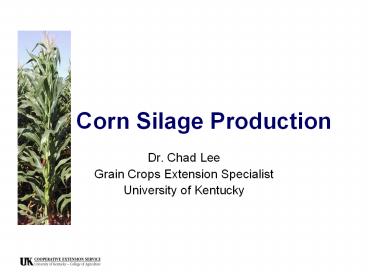Corn Silage Production - PowerPoint PPT Presentation
1 / 20
Title:
Corn Silage Production
Description:
The ensiling process will decrease nitrates by 30 to 50%. Toxic. Do not feed. Over 1.50 ... the sample uniformly and thinly over a microwave safe dish and place ... – PowerPoint PPT presentation
Number of Views:1784
Avg rating:3.0/5.0
Title: Corn Silage Production
1
Corn Silage Production
- Dr. Chad Lee
- Grain Crops Extension Specialist
- University of Kentucky
2
Drought-Stressed Corn Silage is an Option
- Drought-stressed corn that is unlikely to resume
growth should be ensiled. - 85 to 100 of the normal net energy content.
- May contain more crude protein.
- May contain high nitrate concentrations,
especially in the lower third of the plant. - Do not feed until at least 3 weeks after the silo
has been filled.
3
Corn Silage Nitrate Caution
Nitrate (NO3) in Dry Matter Feeding Instructions
0.0 0.44 Safe to feed.
0.44 0.88 Limit to 50 of total dry ration for pregnant animals.
0.88 1.50 Limit to 25 of total dry ration. Avoid feeding pregnant animals.
Over 1.50 Toxic. Do not feed.
At high enough concentrations, nitrates are poisonous to cattle. The ensiling process will decrease nitrates by 30 to 50. At high enough concentrations, nitrates are poisonous to cattle. The ensiling process will decrease nitrates by 30 to 50.
4
Corn Silage Harvesting
- Milk line is ½ to ¾ down the kernel.
- Leaves above the ear should be mostly green.
- Dry matter content should be near 35, slightly
less for storage in bunkers, trenches, or stacks. - Silage should be chopped into lengths of
approximately 3/8 to 1/2 inch.
5
Corn Silage Storage
- Any structure that preserves the green and moist
forage in the absence of air and water. - Silo
- Bunker
- Bags
6
Corn Silage Moisture Microwave Test
- Collect a representative sample of fresh plants.
- Chop the plants in 1 to 2 inch pieces.
- Weight a sample (about 3 to 4 oz or 100 g)
- Spread the sample uniformly and thinly over a
microwave safe dish and place in oven. - Heat for 1 to 2 minutes and weigh. Heat for 30
seconds and reweigh. Repeat until two weight
recordings are similar. If the sample chars, use
the previous weight. - Calculate the percent moisture.
7
Corn Silage Moisture Grab Test
Squeeze a handful of green chop as tightly as
possible for 90 seconds to make a forage ball.
Condition of forage ball Approx. Dry Matter Content
Holds shape and there is considerable free juice Below 30
Holds shape but very little free juice 25 to 30
Falls apart slowly and there is no free juice 30 to 40
Ball falls apart rapidly Above 40
8
Corn Silage Production
- Planting Date
- April 1 to May 1 in western Kentucky
- April 15 to May 15 in eastern and central KY
- Soil temperatures should be above 50oF at a
2-inch depth for 3 or 4 days - Planting Depth
- 1 ½ - 2 inches (depending on moisture and temp)
9
Corn Silage Production
- Planting Population
- 24,000 to 30,000 seeds/acre
- increase of 2,000 seeds/acre over grain corn
- Row Width
- 30 inches
- Fertility
- Follow AGR-1 Lime and Fertilizer Recommendations
10
Corn Silage vs. Grain Production
- Increase plant populations by about 2,000 seeds/A
compared to grain corn. - Add more pounds of potash per acre compared to
grain corn (see AGR-1). - Use a full- to late-season, high grain producing
hybrid.
11
Silo Gases Caution
- Lethal gases - greatest danger is between 12 to
72 hours after filling. - Run the blower.
- Stay out of the silo for at least one week after
filling. - Keep doors closed between silos and barns.
Any experience of the slightest throat irritation
or coughing requires immediate medical attention.
12
Nutrient Sampling for Feed Quality
- Collect a couple handfuls of each load of silage
that is being unloaded. - Keep the samples out of sunlight.
- Mix the samples together.
- Keep refrigerated until sent off for analysis.
13
Silage Publications
- AGR-79 Producing corn for grain and silage
- ID-139 A comprehensive guide to corn management
- AGR-1 Lime and fertilizer recommendations
- AEU-41 Temporary silage storage
- ID-86 Using drought-stressed corn harvesting,
storage, feeding, pricing
14
Corn Hybrid Types
- Dual-Purpose
- Normal corn hybrids used for grain and/or silage
- NutriDense
- Slightly higher oil and protein content in the
kernel - Waxy
- 100 amylopectin (believed to be more digestible)
- Leafy
- Have more leaves above the ear than normal
hybrids - BMR
- Lower lignin content than normal corn, making it
more digestible
15
No-Till Silage Project
- Four hybrids
- Dual Purpose
- Nutri-Dense
- Waxy
- Leafy
- Three Populations
- 22,000
- 27,500
- 33,000
- Two N Fertility Levels
- AGR-1
- Yield Goal
16
Hybrid effect on yield
a
a
a
b
17
N Rate Crude Protein Crude Protein
(lbs/acre) () ()
Green Chop Silage
120 7.43b 7.71b
200 7.81a 8.17a
LSD (0.05) 0.31 0.35
18
Corn YieldsLexington, 2003
Hybrid Type Silage Yield (Tons/A) EarStover (Ratio)
ES112 Dual Purpose 22.1 0.68 a
ES213ND Nutri-Dense 23.0 0.67 a
F2F797 Leafy (TMF) 24.6 0.39 a
8464wx Waxy 15.9 0.66 a
Note Interactions between population, fertility
and replication prevent statistical comparison of
hybrids for silage yield.
19
Corn YieldsLexington, 2003
Hybrid Type Silage Yield (Tons/A) Grain Yield (Bu/A)
ES112 Dual Purpose 22.1 241.4
ES213ND Nutri-Dense 23.0 233.2
F2F797 Leafy (TMF) 24.6 203.5
8464wx Waxy 15.9 194.1
Note Interactions between population, fertility
and replication prevent statistical comparison of
hybrids.
20
No-Till Silage
- Data is being analyzed for second year of
research.






























